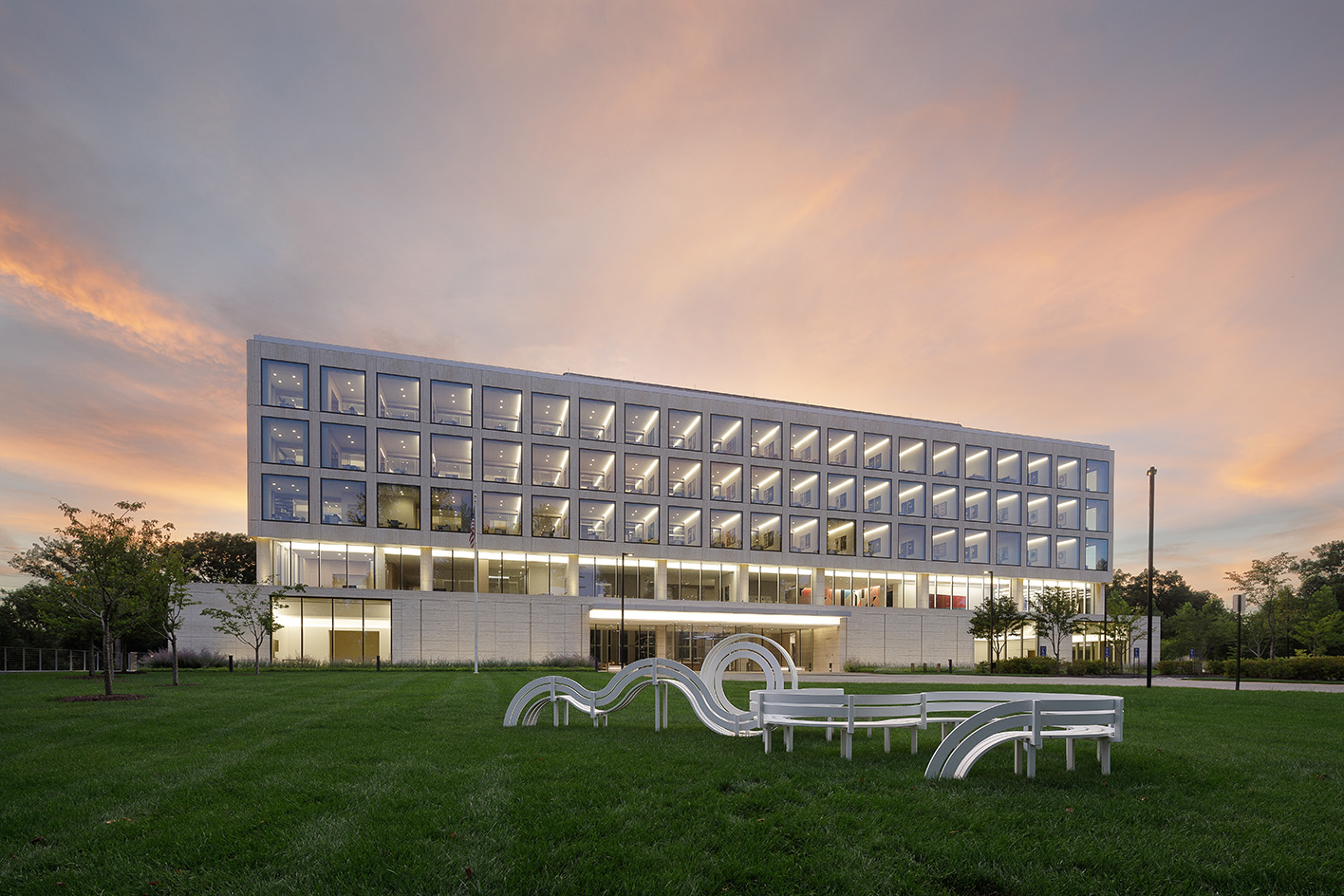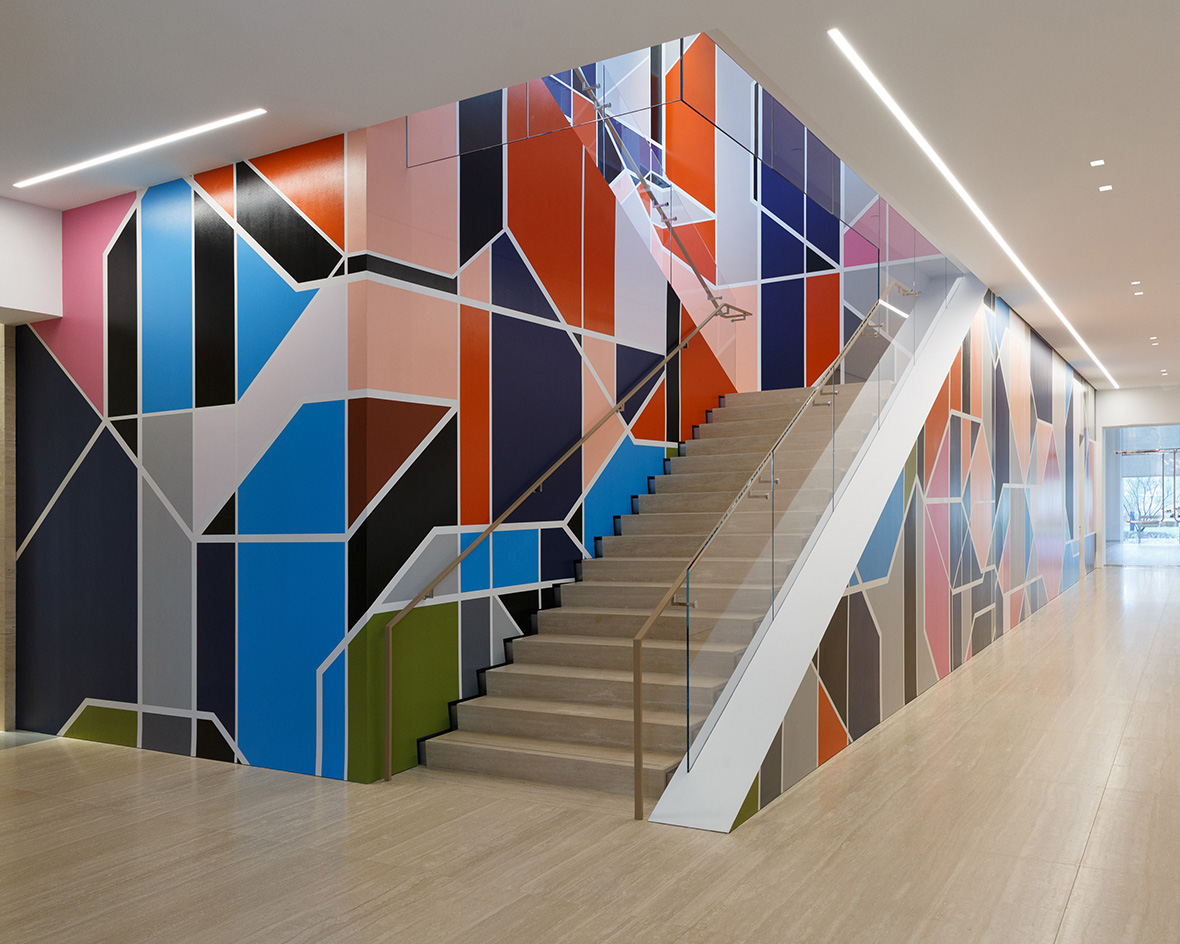Debra Lehman Smith: why architecture needs art
Architecture studio LSM and its co-founder Debra Lehman Smith cultivate creative connections for employees, in the US and beyond

‘Art connects,’ says Debra Lehman Smith. ‘Placing art in the workplace creates unique narratives which enable organisations to articulate their individual culture. Art fosters conversation and connection vital to creating engaging and productive office environments.’ The US-based designer and founding partner at Lehman Smith McLeish (LSM), a Washington DC-based practice with a particular specialty of effortlessly and coherently blending art and architecture in its projects, has worked on numerous workspace projects that make the most of the creative power of the arts since the studio’s foundation in 1991.

Modified Social Bench #48 by Jeppe Hein
Debra Lehman Smith on the relationship between art and architecture
LSM’s newest completions include the headquarters of a leading aerospace and defence company in the Washington DC metropolitan area. Covering some 22 acres, the scheme is reached via a scenic drive, culminating to the sense of arrival created by the Modified Social Bench #48, a site-specific installation piece by Jeppe Hein that is nestled in the lawn in front of the main entrance. More art, by Alicja Kwade (a specially commissioned item), Tacita Dean, and Sarah Morris (a relocated and reinterpreted work), greets visitors on the ground level and its six-storey tall atrium. The building’s strong grid-based geometry is offset by the mesmerising art as much as the green nature outside, composing a peaceful environment for employees and guests inside and out.

Orbit Washington by Alicja Kwade
Lehman Smith’s gentle weaving of art and architecture materialises in almost all her works, found across the US and Europe. For this client, LSM developed the headquarters’ architecture, campus and site layout, interiors, and art. Other examples include two London schemes: Milbank London’s 100 Liverpool Street office, which features space-specific pieces by Jeppe Hein, Idris Khan, and Paul Morrison; and the 100 Bishopsgate headquarters of law firm Paul Hastings, where sleek, mirrored and metal surfaces are fully in sync with the atrium’s moving piece Gravity by Dan Chadwick, among other works.

The Ambassador by Sarah Morris
The designer believes that planning any related art in parallel to the spatial design in each of the studio’s projects is paramount for the success of the final result – art should always be an integral part of the design solution. ‘Our process approaches design with art in mind. In working with passionate clients, art consultants, and leading artists, we are able to shape unique spaces for our clients by placing exceptional works of art in dialogue with excellent architecture,’ she says. ‘We generally find the most success when true collaboration occurs. When all parties involved are working together and challenging one another, both architect and artist are encouraged to strive for and produce their best work.’

Quarantania by Tacita Dean
Receive our daily digest of inspiration, escapism and design stories from around the world direct to your inbox.
Ellie Stathaki is the Architecture & Environment Director at Wallpaper*. She trained as an architect at the Aristotle University of Thessaloniki in Greece and studied architectural history at the Bartlett in London. Now an established journalist, she has been a member of the Wallpaper* team since 2006, visiting buildings across the globe and interviewing leading architects such as Tadao Ando and Rem Koolhaas. Ellie has also taken part in judging panels, moderated events, curated shows and contributed in books, such as The Contemporary House (Thames & Hudson, 2018), Glenn Sestig Architecture Diary (2020) and House London (2022).
-
 This late-night hangout brings back 1970s glam to LA’s Sunset Boulevard
This late-night hangout brings back 1970s glam to LA’s Sunset BoulevardGalerie On Sunset is primed for strong drinks, shared plates, live music, and long nights
-
 How Memphis developed from an informal gathering of restless creatives into one of design's most influential movements
How Memphis developed from an informal gathering of restless creatives into one of design's most influential movementsEverything you want to know about Memphis Design, from its history to its leading figures to the pieces to know (and buy)
-
 Aidia Studio's mesmerising forms blend biophilia and local craft
Aidia Studio's mesmerising forms blend biophilia and local craftMexican architecture practice Aidia Studio's co-founders, Rolando Rodríguez-Leal and Natalia Wrzask, bring together imaginative ways of building and biophilic references
-
 Step inside this resilient, river-facing cabin for a life with ‘less stuff’
Step inside this resilient, river-facing cabin for a life with ‘less stuff’A tough little cabin designed by architects Wittman Estes, with a big view of the Pacific Northwest's Wenatchee River, is the perfect cosy retreat
-
 Remembering Robert A.M. Stern, an architect who discovered possibility in the past
Remembering Robert A.M. Stern, an architect who discovered possibility in the pastIt's easy to dismiss the late architect as a traditionalist. But Stern was, in fact, a design rebel whose buildings were as distinctly grand and buttoned-up as his chalk-striped suits
-
 Own an early John Lautner, perched in LA’s Echo Park hills
Own an early John Lautner, perched in LA’s Echo Park hillsThe restored and updated Jules Salkin Residence by John Lautner is a unique piece of Californian design heritage, an early private house by the Frank Lloyd Wright acolyte that points to his future iconic status
-
 The Stahl House – an icon of mid-century modernism – is for sale in Los Angeles
The Stahl House – an icon of mid-century modernism – is for sale in Los AngelesAfter 65 years in the hands of the same family, the home, also known as Case Study House #22, has been listed for $25 million
-
 Houston's Ismaili Centre is the most dazzling new building in America. Here's a look inside
Houston's Ismaili Centre is the most dazzling new building in America. Here's a look insideLondon-based architect Farshid Moussavi designed a new building open to all – and in the process, has created a gleaming new monument
-
 Frank Lloyd Wright’s Fountainhead will be opened to the public for the first time
Frank Lloyd Wright’s Fountainhead will be opened to the public for the first timeThe home, a defining example of the architect’s vision for American design, has been acquired by the Mississippi Museum of Art, which will open it to the public, giving visitors the chance to experience Frank Lloyd Wright’s genius firsthand
-
 Clad in terracotta, these new Williamsburg homes blend loft living and an organic feel
Clad in terracotta, these new Williamsburg homes blend loft living and an organic feelThe Williamsburg homes inside 103 Grand Street, designed by Brooklyn-based architects Of Possible, bring together elegant interiors and dramatic outdoor space in a slick, stacked volume
-
 This ethereal Miami residence sprouted out of a wild, jungle-like garden
This ethereal Miami residence sprouted out of a wild, jungle-like gardenA Miami couple tapped local firm Brillhart Architecture to design them a house that merged Florida vernacular, Paul Rudolph and 'too many plants to count’